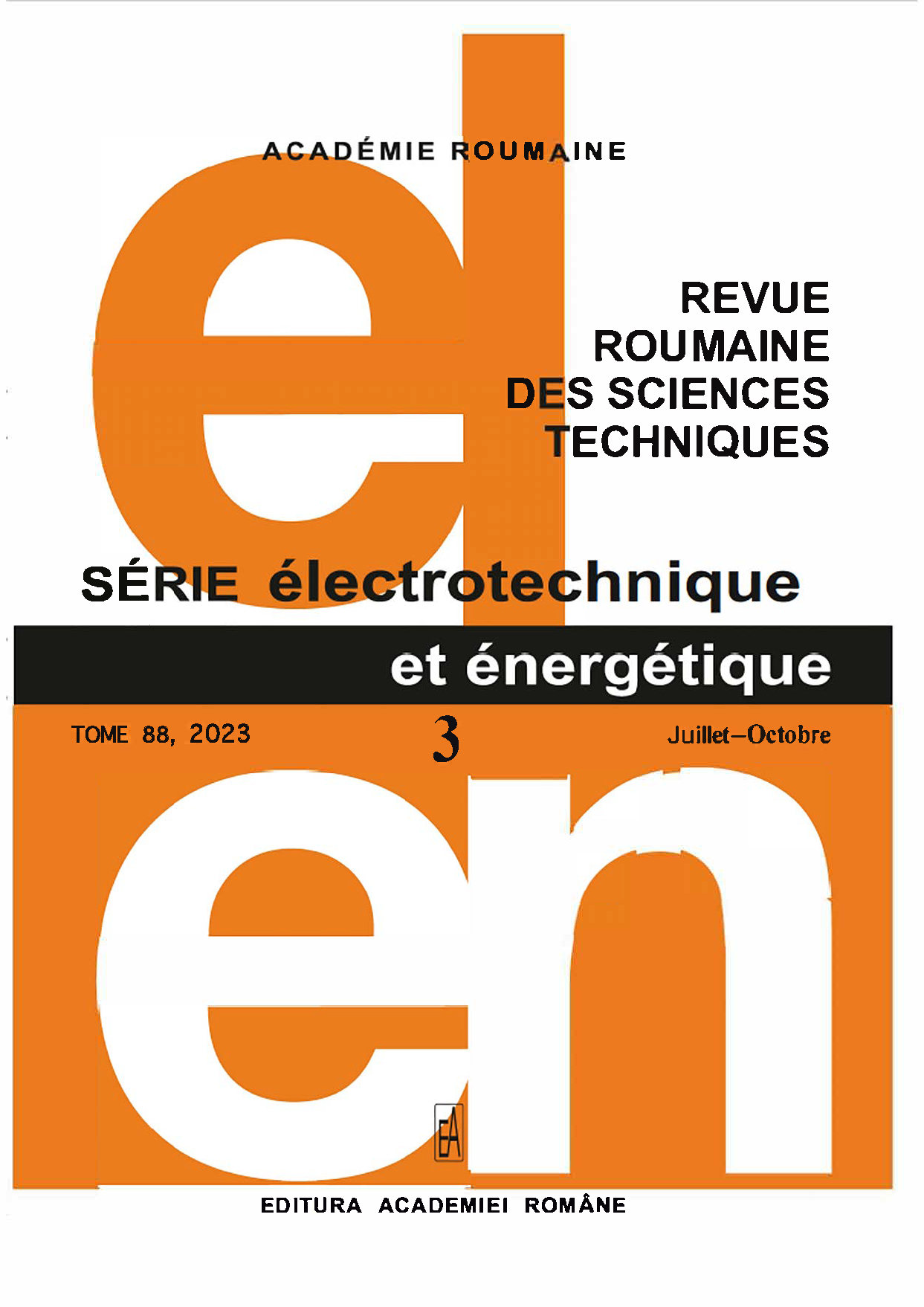CONTRÔLE DU CHAMP MAGNÉTIQUE DANS UNE PLATEFORME ANALYTIQUE POUR L'ÉVALUATION DES BACTÉRIES PATHOGÈNES
DOI :
https://doi.org/10.59277/RRST-EE.2023.3.12Mots-clés :
Actionnement magnétique, Détection d'agents pathogènes, Champ magnétique, Simulation numériqueRésumé
L'article présente une plate-forme conceptuelle et analytique avec diverses applications de détection d'agents pathogènes, basée sur une source de champ magnétique hybride, composée d'aimants permanents et de bobines de solénoïde fixées sur la même culasse magnétique qui agit comme un concentrateur de flux magnétique. Le champ magnétique crée des forces de magnétisation qui guident les microparticules paramagnétiques fonctionnalisées à travers le volume d’un échantillon d’analyte, afin de capturer les agents pathogènes ciblés. La présence de bactéries est détectée à l'aide d'un module supplémentaire de spectroscopie d'impédance électrique (EIS) fixé au système, dans des champs électriques à haute fréquence. Le contrôle du champ magnétique est étudié à l'aide de modélisation mathématique et de simulation numérique dans plusieurs configurations géométriques, d'excitation de bobine et de valeurs de densité de flux rémanent.
Références
(1) Y. Zhu, Y. Zhang, X. Yang, S. Tao, M. Chen, W. Shangguan, Operando investigation of particle re-entrainment mechanism in electrostatic capture process on the lab-on-a-chip, Journal of environmental sciences, 136, pp. 337–347 (2024).
(2) L. Steigmann, S. Maekawa, C. Sima, S. Travan, C.-W. Wang, W.V. Giannobile, Biosensor and Lab-on-a-chip Biomarker-identifying Technologies for Oral and Periodontal Diseases, Front. Pharmacol. 11 p. 1663 (2020).
(3) Y. Ai, F. Zhang, C. Wang, R. Xie, Q. Liang, Recent progress in lab-on-a-chip for pharmaceutical analysis and pharmacological/toxicological test, Trends in Analytical Chemistry, 117, pp. 215-230 (2019).
(4) A. M. Foudeh, T. Fatanat Didar, T. Veres and M. Tabrizian, Lab Chip, 12, pp. 3249–3266 (2012).
(5) H.S. Magar, M.N. Abbas, M.B. Ali, M.A. Ahmed, Picomolar-sensitive impedimetric sensor for salivary calcium analysis at POC based on SAM of Schiff base–modified gold electrode. J. Solid State Electrochem., 24, pp. 723–737 (2020).
(6) S. David, C. Polonschii, M. Gheorghiu, D. Bratu, A. Dobre, E. Gheorghiu, Assessment of pathogenic bacteria using periodic actuation, Lab on a Chip, 13, p. 3192 (2013).
(7) E. Gheorghiu, Detection of pathogenic bacteria by magneto-immunoassays: a review. The Journal of Biomedical Research. 35. 1. 10.7555/JBR.34.20200123 (2021).
(8) F. Munteanu, A.M. Titoiu, J. Marty, A. Vasilescu, Detection of Antibiotics and Evaluation of Antibacterial Activity with Screen-Printed Electrodes. Sensors. 18. 901. 10.3390/s18030901 (2018).
(9) P.H. Lu, Y.D. Ma, C.Y. Fu, G.B. Lee, A structure-free digital microfluidic platform for detection of influenza a virus by using magnetic beads and electromagnetic forces. Lab on a Chip, 4, pp.789–797 (2020).
(10) A.F. Blanco, M.H. Perez, Y.M. Trigos, J. Garcia-Hernandez, Development of Optical Label-Free Biosensor Method in Detection of Listeria monocytogenes from Food. Sensors. 23. 5570. 10.3390/s23125570 (2023).
(11) R. Radhakrishnan, P. Poltronieri, Fluorescence-Free Biosensor Methods in Detection of Food Pathogens with a Special Focus on Listeria monocytogenes. Biosensors, MDPI, ISSN 2079-6374;. 7. 63. 10.3390/bios7040063 (2017)
(12) J. Leva-Bueno, S.A. Peyman, P.A. Millner, A review on impedimetric immunosensors for pathogen and biomarker detection, Med Microbiol Immunol, 209, 3, pp. 343–362 (2020).
(13) J. Vlcek, Pištora, M. Lesnák, Design of plasmonic-waveguiding structures for sensor applications, Nanomaterials, 9, 9, pp. 1227 (2019).
(14) E. Gheorghiu, A renewed challenge to electrical bioimpedance: rapid assessment of pathogenic bacteria, J. Electr. Bioimpedance, 14, 1, pp. 1-2 (Mar. 2023).
(15) E. Gheorghiu, RO Patent Application A00136/2011 (2011).
(16) A.M. Morega, M. Morega, A.A. Dobre, Computational Modeling in Biomedical Engineering and Medical Physics, Chapters 6 and 8 Elsevier, (2020).
(17) A.B. Seabra et al., Chapter 24, Antimicrobial applications of superparamagnetic iron oxide nanoparticles: perspectives and challenges, in Nanostructures for Antimicrobial Therapy, ed. A. A. Ficai, A.M. Grumezescu, Micro and Nano Technologies, pp. 531-550 (2017).
(18) J. Dulińska-Litewka et al., Superparamagnetic iron oxide nanoparticles – current and prospective medical applications, Materials (Basel), 12, 4, pp. 617-642 (2019).
(19) S. Palanisamy Y.M. Wang, Superparamagnetic iron oxide nanoparticulate system: synthesis, targeting, drug delivery and therapy in cancer, Dalton Transactions, 48, 26, pp. 9490-9515 (2019).
(20) C.M. Lundquist et al., Characterization of Free and Porous Silicon-Encapsulated Superparamagnetic Iron Oxide Nanoparticles as Platforms for the Development of Theranostic Vaccines, Med. Sci., 2, 1, pp. 51-69 (2014).
(21) ***ThermoFisher Invitrogen Dynabeads M-280 Streptavidin Certificate of Analysis, Quality Control Report, September 2023, https://www.thermofisher.com/document-connect/document-connect.html?url=https://assets.thermofisher.com/TFS-Assets%2Fcertificate%2FVIL%2FCOA%2FCOA_60210_2812162_1.pdf.
(22) A.M. Morega, M.Morega, J.B. Dumitru, Magnetic field-flow interactions in a miniature electric power transformer with magnetic nanofluid core and solenoid type coils, Rev. Roum. Sci. Techn. – Électrotechn. Et Énerg., 58, 1, pp. 25–34 (2013).
(23) V. Paltanea, G. Paltanea, D. Popovici, Numerical approach for an application of magnetic drug targeting in cancer therapy, Rev. Roum. Sci. Techn. – Électrotechn. Et Énerg., 53, 2, pp. 137–146 (2008).
(24) R.M. Baerov, A.M. Morega, M. Morega, Analysis of magnetotherapy effects for post-traumatic recovery of limb fractures, Rev. Roum. Sci. Techn. – Électrotechn. Et Énerg., 65, 1-2, pp. 145–150 (2020).
Téléchargements
Publiée
Numéro
Rubrique
Licence
(c) Copyright REVUE ROUMAINE DES SCIENCES TECHNIQUES — SÉRIE ÉLECTROTECHNIQUE ET ÉNERGÉTIQUE 2023

Ce travail est disponible sous licence Creative Commons Attribution - Pas d'Utilisation Commerciale - Pas de Modification 4.0 International.


